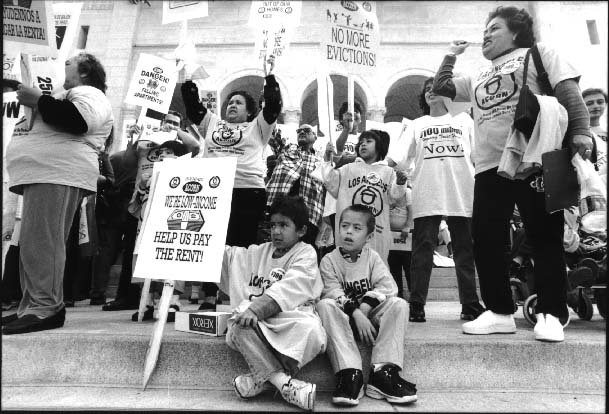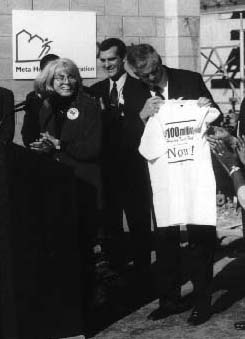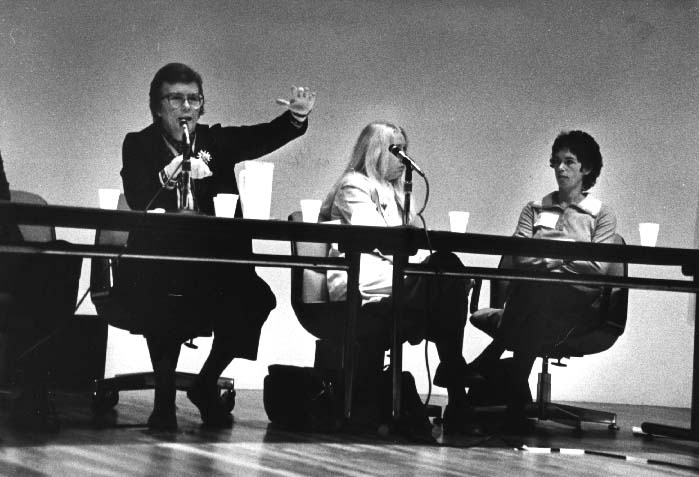January 2002 was not an auspicious time for launching expensive social initiatives in California’s largest city. Still reeling from September 11, Los Angeles faced a $200 million deficit. Mayor James Hahn had imposed a hiring freeze and 10 percent budget cutbacks.
And yet, there was Hahn, on January 17, announcing the establishment of the nation’s largest housing trust fund – $100 million. Despite the city’s fiscal straits, the trust fund had garnered unanimous support. How could such a huge initiative, offered at such a time, generate no opposition? The answer is Housing LA, a three-year campaign so broad and inclusive that opposing its demand for a trust fund of this magnitude was simply not an option.
 |
| Housing LA members joined a November 2001 march and rally organized by ACORN to keep up the pressure for the housing trust fund. Some wore T-shirts reading “$100 Million… Now!” (2nd from right). |
Housing LA was conceived in 1998 when leaders of the Southern California Association of Non-Profit Housing (SCANPH) realized that only a dedicated trust fund – a substantial dedicated trust fund – could jumpstart production of affordable housing for the people of Los Angeles. Our sense of urgency was fueled by the city’s longtime disregard for the housing needs of its low-income residents: The previous city administration had often raided housing dollars for other programs. Housing production was actually cut in half between 1993 and 1998 – although the city’s population increased by 300,000 in the 1990s. Moreover, 61 percent of Los Angeles residents rent because homes are too expensive to buy, one in seven apartments is sub-standard, and a third of all apartments are overcrowded.
**
In any campaign, the early decisions lay the groundwork for later success. Four assumptions became the foundation for our entire campaign:
First, we couldn’t win alone. We knew that a campaign built entirely (or even mostly) on SCANPH’s community development corporation base was too narrow – CDCs would be at the campaign’s core, but the strategy was to bring together different constituencies, with different interests, around the common goal. Our leadership had to come from three major constituencies: labor, the religious community, and tenants.
Second, timing was everything. Los Angeles has term limits, and a new mayor and city council would be elected in July 2001. We wanted to win within the first six months of the new administration, so we planned each phase backwards from December 2001.
Third, we would focus on the fund itself, not its sources. We proposed a number of sources and were open to more, but kept our sights on the amount – $100 million a year.
Fourth, we had an “outside/inside” strategy. The coalition would be built “outside” City Hall before and during the election. When the new administration was sworn in, the campaign would go “inside” and focus on getting the actual votes.
**
We were committed to leadership from outside the community development movement, and that meant we had to convince busy people to add the trust fund to their plate. Ultimately, Housing LA held together because the partners recognized the common good – and their own interests. Religious leaders believed in the morality of our goal, unions wanted jobs and housing for their members, and tenants wanted to get their children out of the slums.
Our first task was to ask the cardinal of the Archdiocese of Los Angeles and the head of LA Federation of Labor to be our honorary chairs. We used existing relationships, both professional and personal. One of our active members had a long relationship with the director of the Archdiocese’s Justice and Peace Commission, and asked him to take our request directly to Cardinal Roger Mahony. The cardinal, known for his commitment to the poor, agreed immediately. He not only chaired the campaign, but spoke at our press conferences, made calls, and wrote letters. Other CDC leaders with religious connections met with the Board of Rabbis, individual temple leaders, and pastors from most of the African-American churches. Thorough research, quality materials and – most importantly – a personal visit to each prelate resulted in positive commitments.
We also drew on various contacts and connections to personally invite participation by key labor leaders. Miguel Contreras, executive secretary of the LA Federation of Labor, not only agreed to be an honorary chair, but spoke at our events, made calls, and used his influence in City Hall to garner support. Other unions signed on: a number of locals from the Service Employees International Union, including the all-important city workers, Justice for Janitors, health care workers, and even the state council. We obtained commitments from the United Food & Commercial Workers, Hotel & Restaurant Employees, the American Federation of State, County and Municipal Employees, the building trades council, and the teachers’ and firefighters’ unions.
Other constituencies recruited to the leadership included activists from our own developer base, environmentalists, disability rights advocates, social service agencies, and social justice organizations such as the living wage and the immigrants’ rights coalitions. Several foundations and a few far-sighted financial institutions also came on board. But tenants were at the heart of it all.
We knew that without the tenants, we would have breadth but no depth. Organized tenants were vital because only they can articulate the suffering that lack of good housing creates – and they were the troops that would swell our numbers when it came time for public actions. Virtually all of the tenant organizing groups in Los Angeles – ACORN, Inquilinos Unidos (Tenants United), the Coalition for Economic Survival, Coalition LA, POWER, LA Metro (an Industrial Areas Foundation affiliate), and Hollywood CAN (Community Action Network) – provided both leadership and troops for the entire campaign.
Tenants did not blindly accept our invitation, however. In the first meetings, they demanded funding for immediate tenant needs, and asked that the entire fund be dedicated to rental assistance. Developers resisted at first; the impetus for the campaign was production need. But an agreement was reached to set aside a small portion of the fund for emergency tenant needs, such as security deposit loans. In exchange, tenants came on board and never faltered. This agreement solidified a working relationship between the developers and tenants that continues: At present, we are working on a Los Angeles-based anti-slum campaign and a statewide effort to revive rent control.
**
Although where the money came from was not our focus, the campaign had to propose politically viable sources for the trust fund.
Trust fund campaigns in California face tremendous political obstacles created by both Propositions 13 and 218 – which, combined, require a two-thirds vote on all taxes and a vote of the affected homeowners on property-based fees. Triggering either of these votes meant losing.
We researched a number of sources, including two fee increases that didn’t require public votes: a commercial linkage fee and an in-lieu fee from an inclusionary zoning ordinance, as well as pots of money that could be re-directed and dedicated to the fund. All of our literature incorporated these proposals, but never emphasized any of them.
Targeting the amount rather than the sources proved to be even smarter than we thought. During the campaign’s final months, we came face to face with potential defeat when the softening economy went into a nosedive after September 11. Because the campaign was about $100 million for housing, rather than about a specific fee or tax whose projected revenue might have declined, at the end of the day it was simply too late for anyone to suggest the fund be anything less than the full $100 million.
There were several milestones over the course of the three-year campaign that solidified our coalition and provided momentum:
- Each year we used the annual publication of the National Low Income Housing Coalition’s Out of Reach to spur media support for the trust fund. In 1999, the media pressure was so great that the city created a Housing Crisis Task Force. Housing LA leadership participated in all its deliberations, so it wasn’t surprising that the first recommendation was for a $100 million trust fund.
- Once the leadership of Housing LA reached critical mass, they were feted at a breakfast meeting with food, a bright new banner and a skit freely stolen from “Who Wants to Be a Millionaire” (aptly titled “Who Wants a $100 Million Trust Fund?”). The meal allowed the leaders to see who else was involved and to relate to one another in the context of this campaign, even if they worked together elsewhere.
- In December 2000, a slum building in the Echo Park neighborhood collapsed early one morning, killing Juan Francisco Pineda, an immigrant raising two small children, and injuring more than 35 people (see Shelterforce #115). The owners had been cited for numerous code violations but had made only cursory repairs, and the old foundation simply gave way. The entire city was outraged: the police threatened criminal charges, and then-Mayor Richard Riordan and the City Council approved generous relocation payments for the tenants and waived legal residency requirements. Nothing Housing LA could have said or done would have had the emotional impact of this unnecessary loss of life. The tragedy gave new force to our already strong resolve – a fact not lost on the candidates then gearing up for their election runs.
- During the primary season in early 2001, Housing LA took mayoral and council candidates on tours of slum housing as well as safe, decent, affordable housing produced by a coalition member. Aboard each van were tenants, labor representatives, and a religious leader or other constituent representative from the campaign leadership. We organized hundreds of supporters to attend community candidate forums, and distributed more than 10,000 copies of a candidate survey.
- Housing LA convened a half-day conference to bring together business interests with housing developers and advocates. It was risky, because we had no idea if the business community would turn out for such an event, but we also recognized the importance of neutralizing potential opposition. The conference was successful beyond our wildest expectations: Most of the business representatives showed up, and even agreed to stay for an afternoon focus group to explore common interests. Slum housing and land use were the top priorities in a joint agenda that, in the end, was not that hard to achieve. The “buzz” we had created in the city was having an impact, because the business community also agreed to the idea of public subsidy for production, even if they disagreed with our suggested fees.
**
In the two months between the primary and the general election, we gathered our forces for the final push. The mayoral finalists – Hahn, a former City Attorney, and former Speaker of the State Assembly Antonio Villaraigosa – both endorsed the trust fund, as did all mayoral and city council primary candidates. Two city council finalists agreed to be our legislative champions. Nonetheless, we used these weeks to solicit more than 150 organizational endorsements, expanding our “outside” support.
On July 1, Mayor Hahn delivered an 11-minute inaugural speech highlighting three priorities. The first was a $100 million trust fund, to be enacted within six months – exactly our deadline. It was time to go “inside.”
In the last months of the three-year campaign, the candidates we had educated were now elected officials engaged in the day-to-day process of political horse-trading. We had to stick to our strategic game plan but also remain flexible in our tactics to make sure our horse came out the winner.
Starting in late August and continuing for almost three months, Housing LA partners committed to weekly lobbying visits in City Hall. Each visit to the mayor or a council member was led by a different constituency with its own theme: One week it was tenants, the following week academics, another week religious leaders, then labor. We were ubiquitous, and a number of staffers asked us not to bother them anymore, they’d vote on whatever we wanted. We came back anyway. When September 11 threatened everything, we accommodated the changed economic reality by proposing a phased-in approach. But we never let up on the full $100 million.
**
All was going well, but December was approaching and momentum would likely fade after the new year. We had to turn out our troops.
 |
Jan Breidenbach, director of Housing LA (at podium), and Los Angeles Mayor James Hahn (with T-shirt) at a press conference on January 17, 2002 annoucing the approval of the trust fund.
Photo Courtesy of SCANPH |
ACORN had earlier planned a housing march for its own members in November, and they brought the idea to Housing LA , which joined more than 400 people who marched, rallied, and packed the City Council chambers. Between Thanksgiving and Christmas, Housing LA partners organized a flurry of activities, including a City Council address by a supportive delegation of state legislators, who also met with the mayor. At a “Homes for the Holidays” event on the steps of City Hall, labor leaders joined tenants in front of a symbolic foundation and reminded the crowd that housing production creates jobs. Our tenant partners organized two caroling sessions (sample lyrics: “We wish we had a Housing Trust Fund/And more housing next year”) and a Las Posadas procession, a Mexican Christmas tradition of going door-to-door seeking shelter. While in City Hall, the carolers were invited into the mayor’s office, where he listened to their stories and re-affirmed his commitment to the trust fund.
In the first week of the new year, the mayor’s deputy called the campaign office and asked us to review their list of sources. After three years, it took about 24 hours and several long conference calls to realize that we had won exactly what we had fought for, and only a couple of weeks after our deadline.
January 17, the day of the Mayor Hahn’s press conference, was also the anniversary of the devastating North-ridge earthquake that destroyed more than 25,000 low-income apartments and killed almost 60 people in 1994. The two dates bracketed the worst of the city’s housing crisis and the best of what we could do about it. Acknowledging both, the mayor invited campaign leaders to be with him at the podium and gave full credit to Housing LA.
On March 1, the City Council unanimously endorsed the mayor’s proposal, with many stating it was their “finest hour” and thanking the advocates for their work. Through the spring, an advisory committee will meet to draft the guidelines for the fund.
At some point, Housing LA will meet and determine what comes next. There are more housing issues to be addressed, but only the partners can decide if these require that Housing LA continue and, if so, in what form. But whatever the decision, we have established solid working relationships through this campaign, there will be new housing every year to come, and Los Angeles is a better place to call home.



Comments